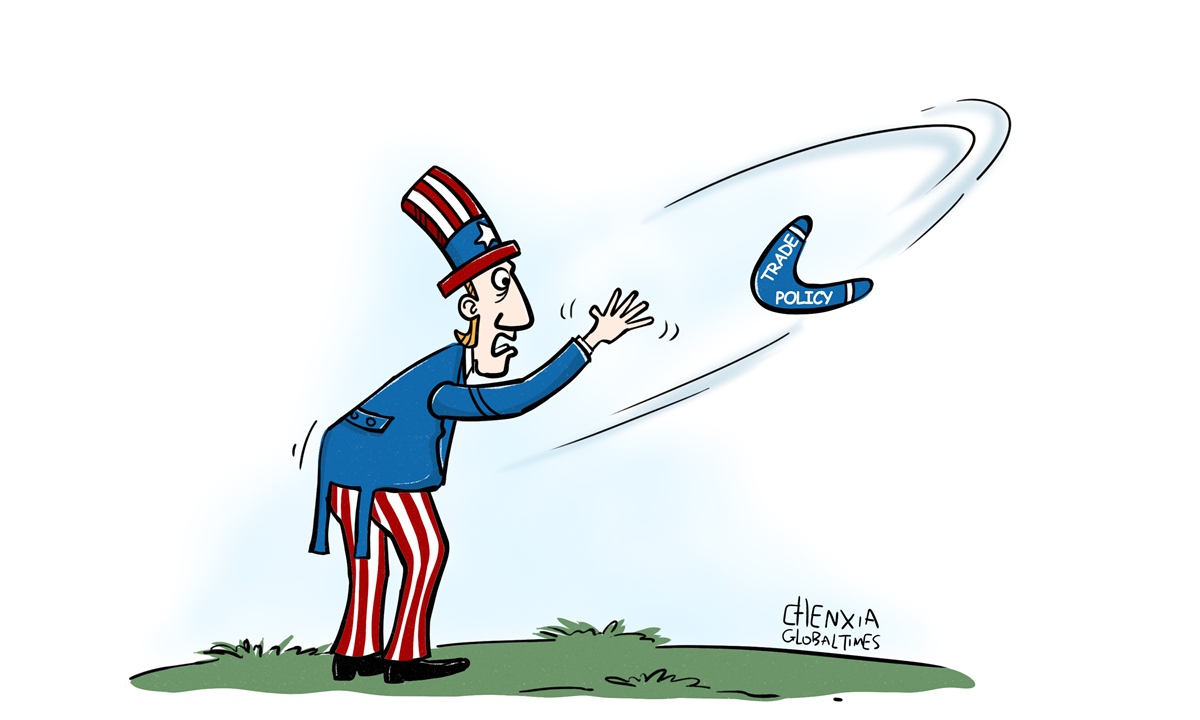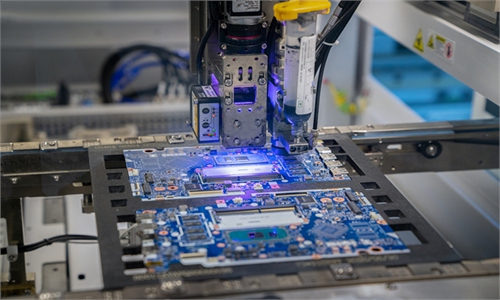
Illustration: Chen Xia/Global Times
The US government on Friday issued a set of draft rules to tighten restrictions of outbound American investments in AI and other leading technologies in China, an ill-intended and selfish move to stymie China's high-tech innovations and perpetuate US' tech supremacy in the world.But the rules will only intensify Chinese efforts to realize quicker research and development of Chinese indigenous technologies, as shown by China's meteoric rise lately in 5G and other leading information technologies, in space exploration, and in new-energy and high-end batteries and electric vehicles innovation.
The draft rules are actually an appendix to US President Joe Biden's executive order in August 2023 to form a mechanism for curtailing outbound investment in semiconductor, quantum information and AI in the so-called foreign "countries of concern," a designation that includes China.
Although Biden administration officials including US Treasury Secretary Janet Yellen always make a case to the world that Washington seeks a "stable and constructive economic relationship with China," the administration, in reality, has done the exactly opposite to damage and impair the relationship. What a mockery on Washington.
The new rules, proposed by the Treasury Department, are reportedly focusing on Chinese mainland, Macao and Hong Kong, aiming to keep US-managed private equity and venture capital funds in the cross-hairs, as well as some US limited partners' investments in foreign managed funds and convertible debt. Those who violate the rules could be subject to both criminal and civil penalties, according to US media reports.
The purpose of the Biden administration is clear for everyone to see - by tightening the restrictions of technology export and controlling its outbound investment to China, Washington aspires to prevent US know-how and US capital from helping Chinese companies to develop AI and other sophisticated technologies that support the next phase of modern manufacturing.
The US is trying to deny China's legitimate right to develop its economy and help fellow developing countries to grow and thrive. In order to take exclusive control of the top end of the value chain, Washington politicians would go so far as to destabilize global industrial and supply chains. But it will not only handicap the global semiconductor industry, but also backfire and do nobody any good in the end.
Efforts to restrict and control China's access to advanced microchips, AI and other technologies will probably have the likelihood of stemming the development of China's AI and other high-tech sectors. However, in a rapidly evolving world, the US attempt to constrain and delay China's ability to acquire and produce advanced AI and microchip technologies is an increasingly challenging job and not easy to materialize.
On the surface, tightened US restrictions have affected China's semiconductor and AI ecosystem, limiting access to equipment and tools essential for next-generation production. In reality, China is intensifying domestic input in advanced microchips and AI innovation, and at the same time, significantly reducing market shares of US firms, and by extension, the revenues US companies need to invest in the next-generation technologies. Also, China is doing its utmost to tap its human resources and engineering advantages to seek its own effective allay of circumventing or replacing US technology.
It is also true that Chinese perceptions of the US' reliability as a responsible supplier have largely changed. Over time, US companies' loss of market share in China could well undermine their future competitiveness.
But the Biden administration is stubborn in implementing its hardline pushes. Facing pushback from some US companies, the administration is nonetheless pursing the set policy of restricting China's access to the most advanced chips and the tools to produce them. The US policy is reportedly envisioned over a five-year time frame.
Since 2022, the world saw the entry into law of the CHIPS and Science Act and the introduction by the US Commerce Department of sweeping new export controls on advanced computing and semiconductor manufacturing items to China. To date, the department has placed more than 600 Chinese organizations and companies and individuals on the "Entity List," with the intention of restricting and banning their access to US technologies.
And, the US government even prodded its allies in Asia and Europe, such as the Netherlands and Japan, to rethink their trade and investment relationship with China, with the allies' own national interests at great peril. This utterly coercive and extraterritorial posturing and way of doing business will ultimately erode global investors' confidence in Washington.
Also, China's homegrown efforts in technology self-reliance have ramped up. In AI though Nvidia's leading-edge A100 and H100 chips have been forbidden to be exported to China, Huawei has overcome the supply gap by constantly improving and turning out the proprietary Ascend series AI processors. And, Shanghai Micro Electronics Equipment Co, the most advanced maker of semiconductor lithography equipment, announced in 2023 that it would start delivery of lithography equipment capable of manufacturing chips at the 28-nanometer node. Before long, aided by the National Integrated Circuit Industry Investment Fund or the "Big Fund," lithography machine capable of producing chips at the 14-namometer node will come out.
So it is a disillusion for Washington to aspire to curtail Chinese tech advances through banning US technology export and restricting its outbound investment. Chinese people's efforts for advancing homegrown innovations will never cease. China isn't to budge before malicious technology crackdown by anyone, which has been proved time and again by history.
The author is an editor with the Global Times. bizopinion@globaltimes.com.cn



